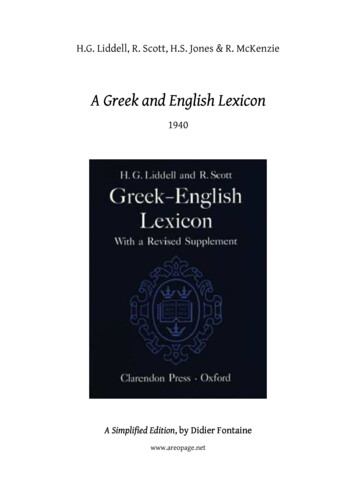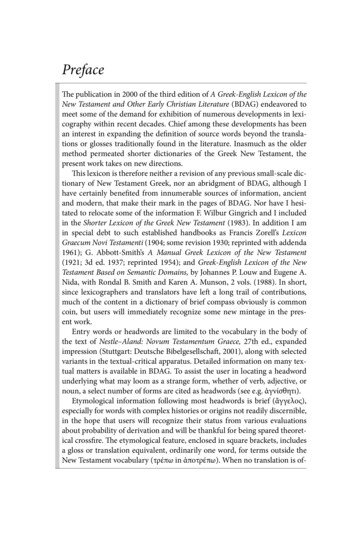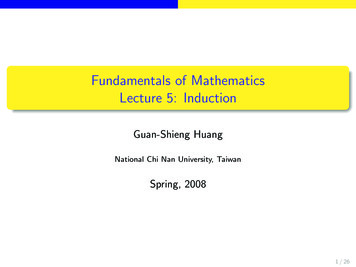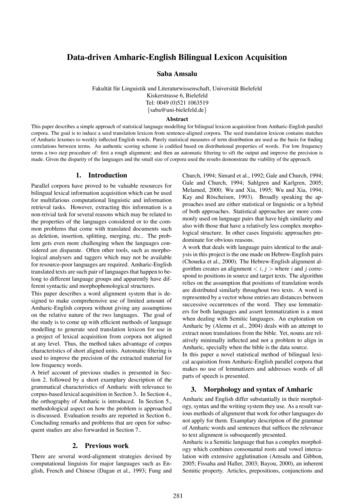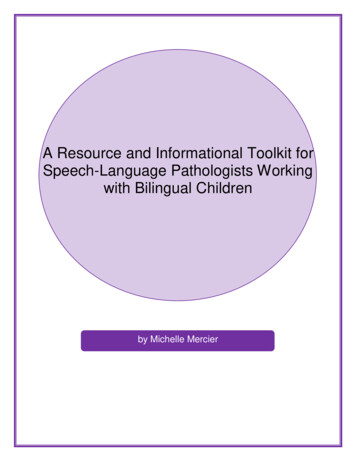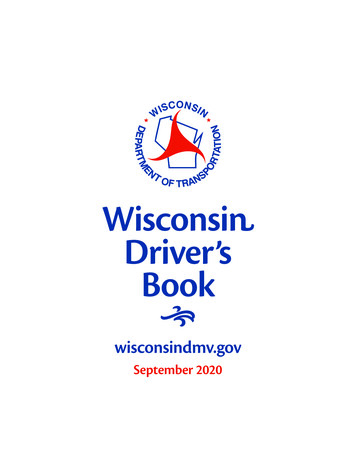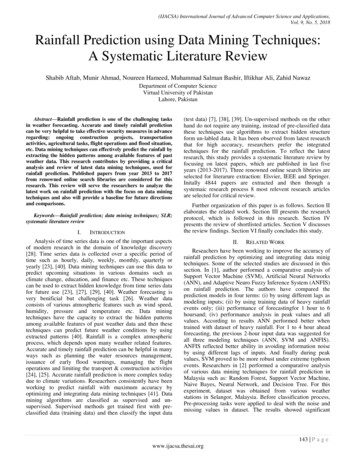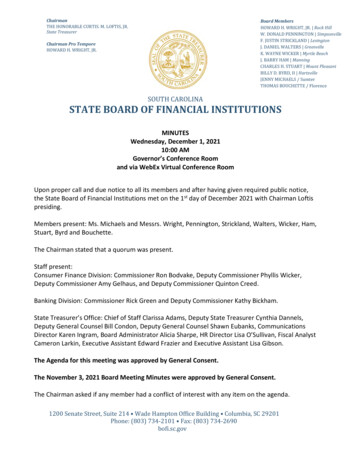Transcription
Supervised Bilingual Lexicon Induction with Multiple Monolingual SignalsAnn IrvineCenter for Language and Speech ProcessingJohns Hopkins UniversityAbstractPrior research into learning translations fromsource and target language monolingual textshas treated the task as an unsupervised learning problem. Although many techniques takeadvantage of a seed bilingual lexicon, thiswork is the first to use that data for supervised learning to combine a diverse set of signals derived from a pair of monolingual corpora into a single discriminative model. Evenin a low resource machine translation setting,where induced translations have the potentialto improve performance substantially, it is reasonable to assume access to some amount ofdata to perform this kind of optimization. Ourwork shows that only a few hundred translation pairs are needed to achieve strong performance on the bilingual lexicon inductiontask, and our approach yields an average relative gain in accuracy of nearly 50% over anunsupervised baseline. Large gains in accuracy hold for all 22 languages (low and highresource) that we investigate.1IntroductionBilingual lexicon induction is the task of identifyingword translation pairs using source and target monolingual corpora, which are often comparable. Mostapproaches to the task are based on the idea thatwords that are translations of one another have similar distributional properties across languages. Priorresearch has shown that contextual similarity (Rapp,1995), temporal similarity (Schafer and Yarowsky,2002), and topical information (Mimno et al., 2009) Performed while faculty at Johns Hopkins UniversityChris Callison-Burch Computer and Information Science Dept.University of Pennsylvaniaare all good signals for learning translations frommonolingual texts.Most prior work either makes use of only one ortwo monolingual signals or uses unsupervised methods (like rank combination) to aggregate orthogonalsignals (Schafer and Yarowsky, 2002; Klementievand Roth, 2006). Surprisingly, no past research hasemployed supervised approaches to combine diversemonolingually-derived signals for bilingual lexiconinduction. The field of machine learning has showndecisively that supervised models dramatically outperform unsupervised models, including for closelyrelated problems like statistical machine translation(Och and Ney, 2002).For the bilingual lexicon induction task, a supervised approach is natural, particularly because computing contextual similarity typically requires a seedbilingual dictionary (Rapp, 1995), and that samedictionary may be used for estimating the parameters of a model to combine monolingual signals.Alternatively, in a low resource machine translation (MT) setting, it is reasonable to assume a smallamount of parallel data from which a bilingual dictionary can be extracted for supervision. In this setting, bilingual lexicon induction is critical for translating source words which do not appear in the parallel data or dictionary.We frame bilingual lexicon induction as a binaryclassification problem; for a pair of source and target language words, we predict whether the two aretranslations of one another or not. For a given sourcelanguage word, we score all target language candidates separately and then rerank them. We usea variety of signals derived from source and target
rbianUkrainianBulgarianSlovakFarsimonolingual corpora as features and use supervisionto estimate the strength of each. In this work we: Use the following similarity metrics derivedfrom monolingual corpora to score word pairs:contextual, temporal, topical, orthographic, andfrequency. For the first time, explore using supervision tocombine monolingual signals and learn a discriminative model for predicting translations. Present results for 22 low and high resourcelanguages paired with English and show largeaccuracy gains over an unsupervised baseline.2Previous WorkPrior work suggests that a wide variety of monolingual signals, including distributional, temporal,topic, and string similarity, may inform bilinguallexicon induction (Rapp, 1995; Fung and Yee, 1998;Rapp, 1999; Schafer and Yarowsky, 2002; Schafer,2006; Klementiev and Roth, 2006; Koehn andKnight, 2002; Haghighi et al., 2008; Mimno etal., 2009; Mausam et al., 2010). Klementiev et al.(2012) use many of those signals to score an existing phrase table for end-to-end MT but do not learnany new translations. Schafer and Yarowsky (2002)use an unsupervised rank-combination method forcombining orthographic, contextual, temporal, andfrequency similarities into a single ranking.Recently, Ravi and Knight (2011), Dou andKnight (2012), and Nuhn et al. (2012) have workedtoward learning a phrase-based translation modelfrom monolingual corpora, relying on deciphermenttechniques. In contrast to that work, we use aseed bilingual lexicon for supervision and multiplemonolingual signals proposed in prior work.Haghighi et al. (2008) and Daumé and Jagarlamudi (2011) use some supervision to learn how toproject contextual and orthographic features into alow-dimensional space, with the goal of representing words which are translations of one anotheras vectors which are close together in that space.However, both of those approaches focus on onlytwo signals, high resource languages, and frequentwords (frequent nouns, in the case of Haghighi etal. (2008)). In our classification framework, we canincorporate any number of monolingual signals, 4.131.247.4104.5287.2972Table 1:Millions of monolingual web crawl andWikipedia word tokenscluding contextual and string similarity, and directlylearn how to combine them.3Monolingual Data and Signals3.1DataThroughout our experiments, we seek to learn howto translate words in a given source language intoEnglish. Table 1 lists our languages of interest,along with the total amount of monolingual datathat we use for each. We use web crawled timestamped news articles to estimate temporal similarity, Wikipedia pages which are inter-linguallylinked to English pages to estimate topic similarity,and both datasets to estimate frequency and contextual similarity. Following Irvine et al. (2010), weuse pairs of Wikipedia page titles to train a simpletransliterator for languages written in a non-Romanscript, which allows us to compute orthographicsimilarity for pairs of words in different scripts.3.2SignalsOur definitions of orthographic, topic, temporal, andcontextual similarity are taken from Klementiev etal. (2012), and the details of each may be foundthere. Here, we give briefly describe them and giveour definition of a novel, frequency-based signal.Orthographic We measure orthographic similarity between a pair of words as the normalized1 editdistance between the two words. For non-Romanscript languages, we transliterate words into the Roman script before measuring orthographic similarity.Topic We use monolingual Wikipedia pages to estimate topical signatures for each source and target1Normalized by the average of the lengths of the two words
language word. Signature vectors are the length ofthe number of inter-lingually linked source and English Wikipedia pages and contain counts of howmany times the word appears on each page. We usecosine similarity to compare pairs of signatures.Temporal We use time-stamped web crawl datato estimate temporal signatures, which, for a givenword, are the length of the number of time-stamps(dates) and contain counts of how many times theword appears in news articles with the given date.We use a sliding window of three days and use cosine similarity to compare signatures. We expectthat source and target language words which aretranslations of one another will appear with similarfrequencies over time in monolingual data.Contextual We score monolingual contextualsimilarity by first collecting context vectors for eachsource and target language word. The context vectorfor a given word contains counts of how many timeswords appear in its context. We use bag of wordscontexts in a window of size two. We gather bothsource and target language contextual vectors fromour web crawl data and Wikipedia data (separately).Frequency Words that are translations of one another are likely to have similar relative frequenciesin monolingual corpora. We measure the frequencysimilarity of two words as the absolute value of thedifference between the logs of their relative monolingual corpus frequencies.4Supervised Bilingual Lexicon Induction4.1BaselineOur unsupervised baseline method is based onranked lists derived from each of the signals listedabove. For each source word, we generate rankedlists of English candidates using the following sixsignals: Crawls Context, Crawls Time, WikipediaContext, Wikipedia Topic, Edit distance, and LogFrequency Difference. Then, for each English candidate we compute its mean reciprocal rank2 (MRR)based on the six ranked lists. The baseline ranks English candidates according to the MRR scores. Forevaluation, we use the same test sets, accuracy metric, and correct translations described below.PN1The MRR of the jth English word, ej , is N1i 1 rankij ,where N is the number of signals and rankij is ej ’s rank according to signal i.24.2Supervised ApproachIn addition to the monolingual resources describedin Section 3.1, we have a bilingual dictionary foreach language, which we use to project context vectors and for supervision and evaluation. For eachlanguage, we choose up to 8, 000 source languagewords among those that occur in the monolingualdata at least three times and that have at least onetranslation in our dictionary. We randomly dividethe source language words into three equally sizedsets for training, development, and testing. We usethe training data to train a classifier, the development data to choose the best classification settingsand feature set, and the test set for evaluation.For all experiments, we use a linear classifiertrained by stochastic gradient descent to minimizesquared error3 and perform 100 passes over thetraining data.4 The binary classifiers predict whethera pair of words are translations of one another or not.The translations in our training data serve as positive supervision, and the source language words inthe training data paired with random English words5serve as negative supervision. We used our development data to tune the number of negative examplesto three for each positive example. At test time, after scoring all source language words in the test setpaired with all English words in our candidate set,6we rank the English candidates by their classification scores and evaluate accuracy in the top-k translations.4.3FeaturesOur monolingual features are listed below and arebased on raw similarity scores as well as ranks: Crawls Context: Web crawl context similarity score Crawls Context RR: reciprocal rank of crawls context3We tried using logistic rather than linear regression, butperformance differences on our development set were verysmall and not statistically significant.4We use http://hunch.net/ vw/ version 6.1.4, andrun it with the following arguments that affect how updates aremade in learning: –exact adaptive norm –power t 0.55Among those that appear at least five times in our monolingual data, consistent with our candidate set.6All English words appearing at least five times in ourmonolingual data. In practice, we further limit the set to thosethat occur in the top-1000 ranked list according to at least oneof our signals.
1.0Accuracy in Top 10Accuracy in Top 101.00.80.80.60.60.40.20.4 0.20.0 CrawlContextEditDistCrawl WikiWikiTime Context Topic0.0Is Diff DiscrimIdent. Lg Frq AllFigure 1: Each box-and-whisker plot summarizes per-formance on the development set using the given feature(s) across all 22 languages. For each source wordin our development sets, we rank all English target wordsaccording to the monolingual similarity metric(s) listed.All but the last plot show the performance of individualfeatures. Discrim-All uses supervised data to train classifiers for each language based on all of the features. Crawls Time: Web crawl temporal similarity score Crawls Time RR: reciprocal rank of crawls time Edit distance: normalized (by average length ofsource and target word) edit distance Edit distance RR: reciprocal rank of edit distance Wiki Context: Wikipedia context similarity score Wiki Context RR: recip. rank of wiki context Wiki Topic: Wikipedia topic similarity score Wiki Topic RR: recip. rank of wiki topic Is-Identical: source and target words are the same Difference in log frequencies: Difference betweenthe logs of the source and target word monolingualfrequencies Log Freqs Diff RR: reciprocal rank of difference inlog frequenciesWe train classifiers separately for each source language, and the learned weights vary based on, forexample, corpora size and the relatedness of thesource language and English (e.g. edit distance isinformative if there are many cognates). In order touse the trained classifiers to make top-k translationpredictions for a given source word, we rank candidates by their classification scores.4.4 Feature Evaluation and SelectionAfter training initial classifiers, we use our development data to choose the most informative subset offeatures. Figure 1 shows the top-10 accuracy on thedevelopment data when we use individual featuresWikiTopicWikiDiffEditContext Log Freq Dist.EditCrawlAllDist. RR Context FeaturesFigure 2: Performance on the development set goes upas features are greedily added to the feature space. Meanperformance is slightly higher using this subset of six features (second to last bar) than using all features (last bar).to predict translations. Top-10 accuracy refers to thepercent of source language words for which a correctEnglish translation appears in the top-10 ranked English candidates. Each box-and-whisker plot summarizes performance over the 22 languages. Wedon’t display reciprocal rank features, as their performance is very similar to that of the corresponding raw similarity score. It’s easy to see that featuresbased on the Wikipedia topic signal are the most informative. It is also clear that training a supervisedmodel to combine all of the features (the last plot)yields performance that is dramatically higher thanusing any individual feature alone.Figure 2, from left to right, shows a greedy searchfor the best subset of features among those listedabove. Again, the Wikipedia topic score is the mostinformative stand-alone feature, and the Wikipediacontext score is the most informative second feature.Adding features to the model beyond the six shownin the figure does not yield additional performancegains over our set of languages.4.5Learning Curve AnalysisFigure 3 shows learning curves over the number ofpositive training instances. In all cases, the numberof randomly generated negative training instancesis three times the number of positive. For all languages, performance is stable after about 300 correct translations are used for training. This showsthat our supervised method for combining signalsrequires only a small training dictionary.
Accuracy in Top 100.8 0.60.40.2 0.0 0 UrduNepali1200Positive training data instancesFigure 3: Learning curves over number of positive train-1.0Spanish0.8Accuracy1.00.4HindiTamilBengali SerbianUzbekAzeriUrdu FarsiSomaliNepali0.01e 011e 001e 011e 021e 03Millions of Monolingual Word TokensFigure 4: Millions of monolingual word tokens vs. Lexicon Induction Top-10 anSerbianUkrainianBulgarianSlovakFarsiResultsWe use a model based on the six features shownin Figure 2 to score and rank English translationcandidates for the test set words in each language.Table 2 gives the result for each language for theMRR baseline and our supervised technique. Acrosslanguages, the average top-10 accuracy using theMRR baseline is 30.4, and the average using ourtechnique is 43.9, a relative improvement of about44%. We did not attempt a comparison with moresophisticated unsupervised rank aggregation methods. However, we believe the improvements weobserve drastically outweigh the expected performance differences between different rank aggregation methods. Figure 4 plots the accuracies yieldedby our supervised technique versus the total amountof monolingual data for each language. An increasein monolingual data tends to improve accuracy. Thecorrelation isn’t perfect, however. For example, performance on Urdu and Farsi is relatively poor, despite the large amounts of monolingual data available for each. This may be due to the fact that wehave large web crawls for those languages, but theirWikipedia datasets, which tend to provide a strongtopic signal, are relatively small.0.60.2ing instances, up to 1250. For some languages, 1250positive training instances are not available. In all cases,evaluation is on the development data and the number ofnegative training instances is three times the number ofpositive. For all languages, performance is fairly stableafter about 300 positive training instances.5RomanianPolishIndonesianWelsh BulgarianBosnianTurkish SlovakLatvianAlbanian .652.134.667.121.285.0Table 2: Top-10 Accuracy on test set. Performanceincreases for all languages moving from the baseline(MRR) to discriminative training (Supv).6ConclusionsOn average, we observe relative gains of more than44% over an unsupervised rank-combination baseline by using a seed bilingual dictionary and a diverse set of monolingual signals to train a supervisedclassifier. Using supervision for bilingual lexicon induction makes sense. In some cases a dictionary isalready assumed for computing contextual similarity, and, in the remaining cases, one could be compiled easy, either automatically, e.g. Haghighi et al.(2008), or through crowdsourcing, e.g. Irvine andKlementiev (2010) and Callison-Burch and Dredze(2010). We have shown that only a few hundredtranslation pairs are needed to achieve good performance. Our framework has the additional advantagethat any new monolingually-derived similarity metrics can easily be added as new features.
7AcknowledgementsThis material is based on research sponsored byDARPA under contract HR0011-09-1-0044 and bythe Johns Hopkins University Human LanguageTechnology Center of Excellence. The views andconclusions contained in this publication are thoseof the authors and should not be interpreted as representing official policies or endorsements of DARPAor the U.S. Government.ReferencesChris Callison-Burch and Mark Dredze. 2010. Creatingspeech and language data with Amazon’s MechanicalTurk. In Proceedings of the NAACL Workshop on Creating Speech and Language Data with Amazon’s Mechanical Turk.Hal Daumé, III and Jagadeesh Jagarlamudi. 2011. Domain adaptation for machine translation by mining unseen words. In Proceedings of the Conference of theAssociation for Computational Linguistics (ACL).Qing Dou and Kevin Knight. 2012. Large scale decipherment for out-of-domain machine translation. InProceedings of the Joint Conference on EmpiricalMethods in Natural Language Processing and Computational Natural Language Learning.Pascale Fung and Lo Yuen Yee. 1998. An IR approachfor translating new words from nonparallel, comparable texts. In Proceedings of the Conference of the Association for Computational Linguistics (ACL).Aria Haghighi, Percy Liang, Taylor Berg-Kirkpatrick,and Dan Klein. 2008. Learning bilingual lexiconsfrom monolingual corpora. In Proceedings of the Conference of the Association for Computational Linguistics (ACL).Ann Irvine and Alexandre Klementiev. 2010. Using mechanical turk to annotate lexicons for less commonlyused languages. In Proceedings of the NAACL Workshop on Creating Speech and Language Data withAmazon’s Mechanical Turk.Ann Irvine, Chris Callison-Burch, and Alexandre Klementiev. 2010. Transliterating from all languages. InProceedings of the Conference of the Association forMachine Translation in the Americas (AMTA).Alexandre Klementiev and Dan Roth. 2006. Weaklysupervised named entity transliteration and discoveryfrom multilingual comparable corpora. In Proceedings of the Conference of the Association for Computational Linguistics (ACL).Alex Klementiev, Ann Irvine, Chris Callison-Burch, andDavid Yarowsky. 2012. Toward statistical machinetranslation without parallel corpora. In Proceedings ofthe Conference of the European Association for Computational Linguistics (EACL).Philipp Koehn and Kevin Knight. 2002. Learning atranslation lexicon from monolingual corpora. In ACLWorkshop on Unsupervised Lexical Acquisition.Mausam, Stephen Soderland, Oren Etzioni, Daniel S.Weld, Kobi Reiter, Michael Skinner, Marcus Sammer,and Jeff Bilmes. 2010. Panlingual lexical translation via probabilistic inference. Artificial Intelligence,174:619–637, June.David Mimno, Hanna Wallach, Jason Naradowsky, DavidSmith, and Andrew McCallum. 2009. Polylingualtopic models. In Proceedings of the Conference onEmpirical Methods in Natural Language Processing(EMNLP).Malte Nuhn, Arne Mauser, and Hermann Ney. 2012.Deciphering foreign language by combining languagemodels and context vectors. In Proceedings of theConference of the Association for Computational Linguistics (ACL).Franz Josef Och and Hermann Ney. 2002. Discriminative training and maximum entropy models for statistical machine translation. In Proceedings of the Conference of the Association for Computational Linguistics(ACL).Reinhard Rapp. 1995. Identifying word translations innon-parallel texts. In Proceedings of the Conference ofthe Association for Computational Linguistics (ACL).Reinhard Rapp. 1999. Automatic identification of wordtranslations from unrelated English and German corpora. In Proceedings of the Conference of the Association for Computational Linguistics (ACL).Sujith Ravi and Kevin Knight. 2011. Deciphering foreign language. In Proceedings of the Conference ofthe Association for Computational Linguistics (ACL).Charles Schafer and David Yarowsky. 2002. Inducing translation lexicons via diverse similarity measuresand bridge languages. In Proceedings of the Conference on Natural Language Learning (CoNLL).Charles Schafer. 2006. Translation Discovery Using Diverse Similarity Measures. Ph.D. thesis, Johns Hopkins University.
bilingual dictionary (Rapp, 1995), and that same dictionary may be used for estimating the param-eters of a model to combine monolingual signals. Alternatively, in a low resource machine transla-tion (MT) setting, it is reasonable to assume a small amount of parallel data from which a bilingual dic-tionary can be extracted for supervision. In .

